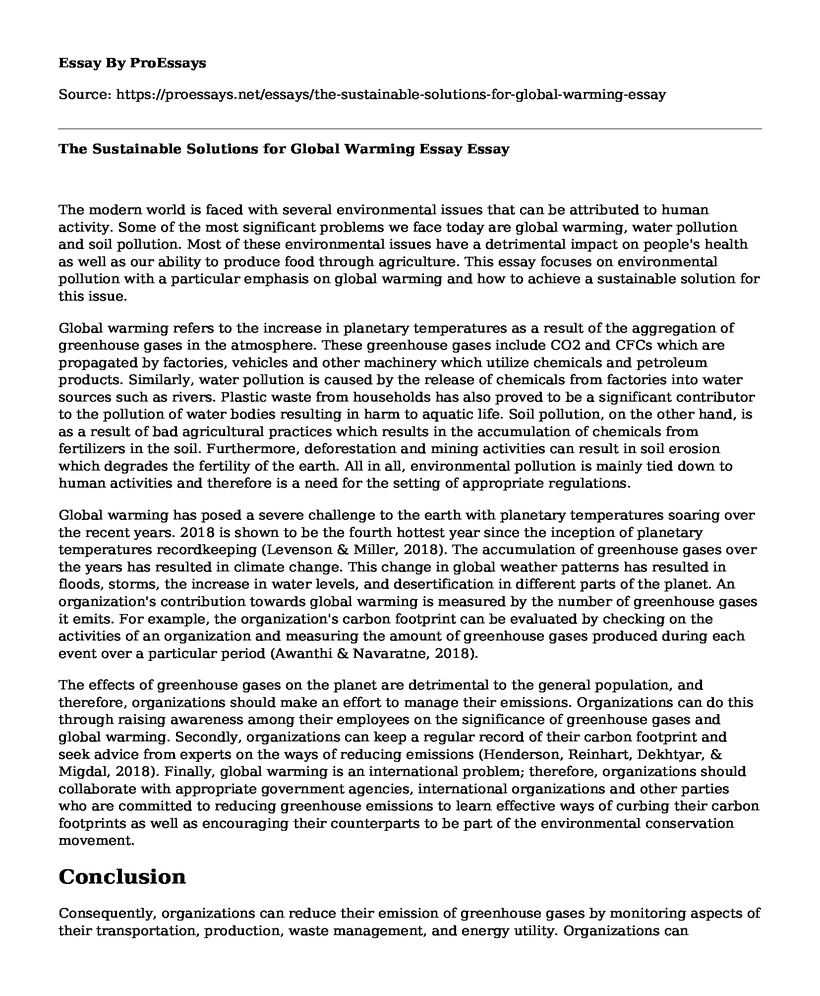The modern world is faced with several environmental issues that can be attributed to human activity. Some of the most significant problems we face today are global warming, water pollution and soil pollution. Most of these environmental issues have a detrimental impact on people's health as well as our ability to produce food through agriculture. This essay focuses on environmental pollution with a particular emphasis on global warming and how to achieve a sustainable solution for this issue.
Global warming refers to the increase in planetary temperatures as a result of the aggregation of greenhouse gases in the atmosphere. These greenhouse gases include CO2 and CFCs which are propagated by factories, vehicles and other machinery which utilize chemicals and petroleum products. Similarly, water pollution is caused by the release of chemicals from factories into water sources such as rivers. Plastic waste from households has also proved to be a significant contributor to the pollution of water bodies resulting in harm to aquatic life. Soil pollution, on the other hand, is as a result of bad agricultural practices which results in the accumulation of chemicals from fertilizers in the soil. Furthermore, deforestation and mining activities can result in soil erosion which degrades the fertility of the earth. All in all, environmental pollution is mainly tied down to human activities and therefore is a need for the setting of appropriate regulations.
Global warming has posed a severe challenge to the earth with planetary temperatures soaring over the recent years. 2018 is shown to be the fourth hottest year since the inception of planetary temperatures recordkeeping (Levenson & Miller, 2018). The accumulation of greenhouse gases over the years has resulted in climate change. This change in global weather patterns has resulted in floods, storms, the increase in water levels, and desertification in different parts of the planet. An organization's contribution towards global warming is measured by the number of greenhouse gases it emits. For example, the organization's carbon footprint can be evaluated by checking on the activities of an organization and measuring the amount of greenhouse gases produced during each event over a particular period (Awanthi & Navaratne, 2018).
The effects of greenhouse gases on the planet are detrimental to the general population, and therefore, organizations should make an effort to manage their emissions. Organizations can do this through raising awareness among their employees on the significance of greenhouse gases and global warming. Secondly, organizations can keep a regular record of their carbon footprint and seek advice from experts on the ways of reducing emissions (Henderson, Reinhart, Dekhtyar, & Migdal, 2018). Finally, global warming is an international problem; therefore, organizations should collaborate with appropriate government agencies, international organizations and other parties who are committed to reducing greenhouse emissions to learn effective ways of curbing their carbon footprints as well as encouraging their counterparts to be part of the environmental conservation movement.
Conclusion
Consequently, organizations can reduce their emission of greenhouse gases by monitoring aspects of their transportation, production, waste management, and energy utility. Organizations can encourage carpooling, walking and utilization of alternative means of transport such as cycling among their staff. Secondly, the organization can promote conservation of energy by the team at the workplace. These interventions aim to reduce the carbon footprint to less than four tons per person (World Health Organization, 2008). The company could also reduce carbon emissions by using alternative sources of energy such as solar energy instead of petroleum products. Waste from factories and other organizations is likely to release gases like methane and CO2 into the environment. Therefore, organizations should put in place strategies such as recycling to reduce their carbon footprint. Recycling can effectively reduce the cost of producing new raw materials and thus save on energy. By taking these steps to evaluate and mitigate carbon emissions, organizations can ensure a sustainable method of addressing global warming.
References
Awanthi, M., & Navaratne, C. (2018). Carbon Footprint of an Organization: a Tool for Monitoring Impacts on Global Warming. Procedia Engineering, 212, 729-735. doi:10.1016/j.proeng.2018.01.094
Henderson, R. M., Reinhart, S. A., Dekhtyar, P., & Migdal, A. (2018). Climate change in 2018: Implications for businesses. Harvard Business School, 9(32), 1-39.
Levenson, E., & Miller, B. (2018, July 28). 2018 is on pace to be the 4th-hottest year on record. Retrieved from https://edition.cnn.com/2018/07/28/us/2018-global-heat-record-4th-wxc/index.html
World Health Organization. (2008). Reducing your carbon footprint can be useful for your health: A list of mitigating actions. Protecting health from climate change, 1-4.
Cite this page
The Sustainable Solutions for Global Warming Essay. (2022, Aug 04). Retrieved from https://proessays.net/essays/the-sustainable-solutions-for-global-warming-essay
If you are the original author of this essay and no longer wish to have it published on the ProEssays website, please click below to request its removal:
- Paper Example on Ocean Sustainability
- Essay Sample on Nature as Perceived by Man
- Green Initiatives for Sustainable and Livable Community Essay
- Atmospheric Pollution and Other Issues Essay Example
- Article Analysis Essay on "What the Litterers Tell Themselves" and "Poverty in America"
- Essay on Gas Incident in Bhopal: An Accident With Deadly Consequences
- Essay Example on Acid Rain: Causes, Effects & Solutions







